We put the Google Pixel 6 Pro through our rigorous DXOMARK Display test suite to measure its performance across six criteria. In this test results, we will break down how it fared in a variety of tests and several common use cases.
Overview
Key display specifications:
- 6.7-inch AMOLED screen
- Resolution: 3120 x 1440 pixels (512 ppi)
- Aspect ratio: 19.5:9
- Refresh rate: 120 Hz
Scoring
Sub-scores and attributes included in the calculations of the global score.


 28th
28th
 22nd
22nd
Pros
- Faithful colors, especially indoors and outdoors in shade
- Smooth when gaming, browsing, and in the gallery app
- Acceptable brightness in most tested conditions
- Well-managed judder and frame drops when watching videos
Cons
- Brightness is too low when watching HDR10 content
- Lacks brightness and shows a strong orange cast under sunlight
- Visible steps during adaptation to changes in lighting environment
Despite slightly low brightness at its default settings when playing videos, the Google Pixel 6 Pro put in a satisfactory performance overall in our Display protocol tests. It has very good color and a comfortably smooth touch.
The Google Pixel 6 Pro is a device whose screen is suitable for essentially all uses. Colors are faithful, touch feels very smooth, and brightness is appropriate in most environments. Its only weakness is in video, where its default brightness is a bit low and playback takes a bit long to resume.
Test summary
About DXOMARK Display tests: For scoring and analysis in our smartphone and other display reviews, DXOMARK engineers perform a variety of objective and perceptual tests under controlled lab and real-life conditions. Note that we evaluate display attributes using only the device’s built-in display hardware and its still image (gallery) and video apps at their default settings. (For in-depth information about how we evaluate smartphone and other displays, check out our articles, “How DXOMARK tests display quality” and “A closer look at DXOMARK Display testing.”
The following section gathers key elements of our exhaustive tests and analyses performed in DXOMARK laboratories. Detailed performance evaluations under the form of reports are available upon request. Do not hesitate to contact us.
Readability
Google Pixel 6 Pro
160
Readability evaluates how easily and comfortably users can read still content (photos & web) on the display under different real-life conditions. DXOMARK uses its Display Bench to recreate ambient light conditions ranging from total darkness to bright sunlight. In addition to laboratory tests, perceptual analysis is also made in real-life environments.
The Google Pixel 6 Pro has comfortable brightness in low-light conditions.
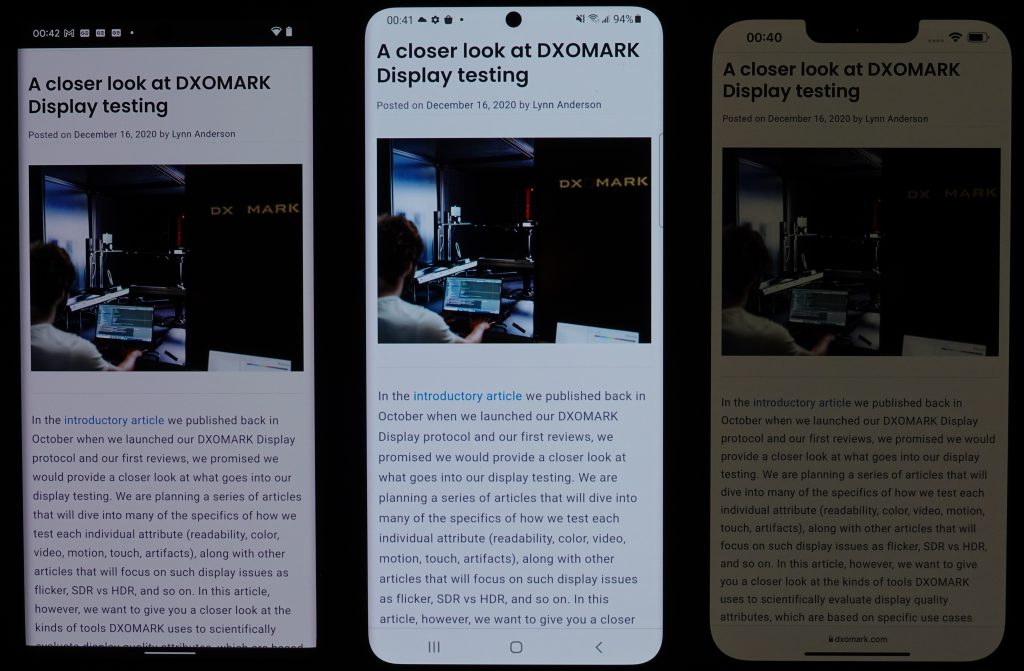
The Pixel 6 Pro also has satisfactory readability in indoor conditions.

Brightness adaptation can be a bit slow to react and a step is noticeable during transitions. The device loses brightness and contrast in angle but remains readable.
In direct sunlight, the Pixel 6 Pro could be a bit brighter; content is still legible, but less so. (The other devices also struggle to perform well in direct sunlight.) We measured the Pixel 6’s brightness at 1075 cd/m² outdoors under sunlight, but the device did not achieve such brightness during our test bench measurements. Thus the value given in the 30K lux graph above is approximately 500 cd/m2.
Color
Google Pixel 6 Pro
163
The color attribute evaluates the capacity of the device to accurately reproduce colors. The measurements taken are for fidelity, white point color, and gamut coverage. We perform color evaluations for different lighting conditions to see how well the device can manage color in the surrounding environment. Colors are measured using a spectrophotometer in a controlled lighting environment. Perceptual analysis of color rendering is against the reference pattern displayed on a calibrated professional monitor.
Images viewed on the Google Pixel 6 Pro in bright outdoor conditions show an orangish cast, but the rendering is nonetheless acceptable. In shady conditions and indoors, colors are accurate.
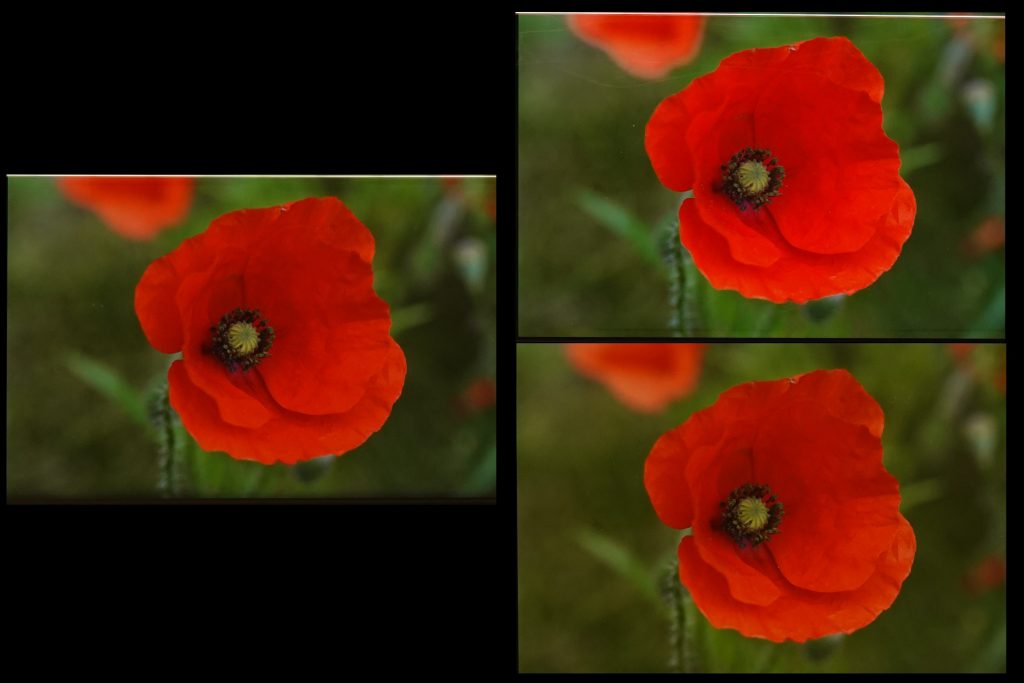

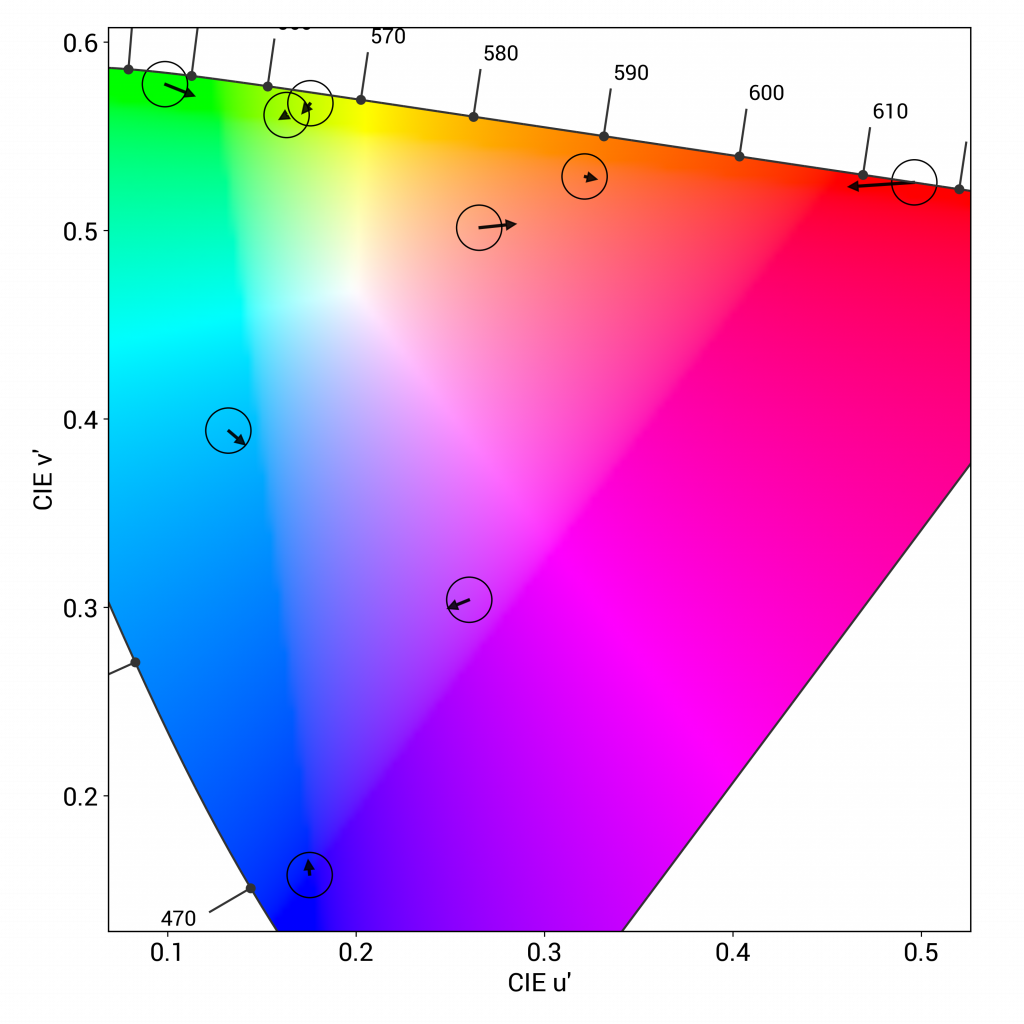
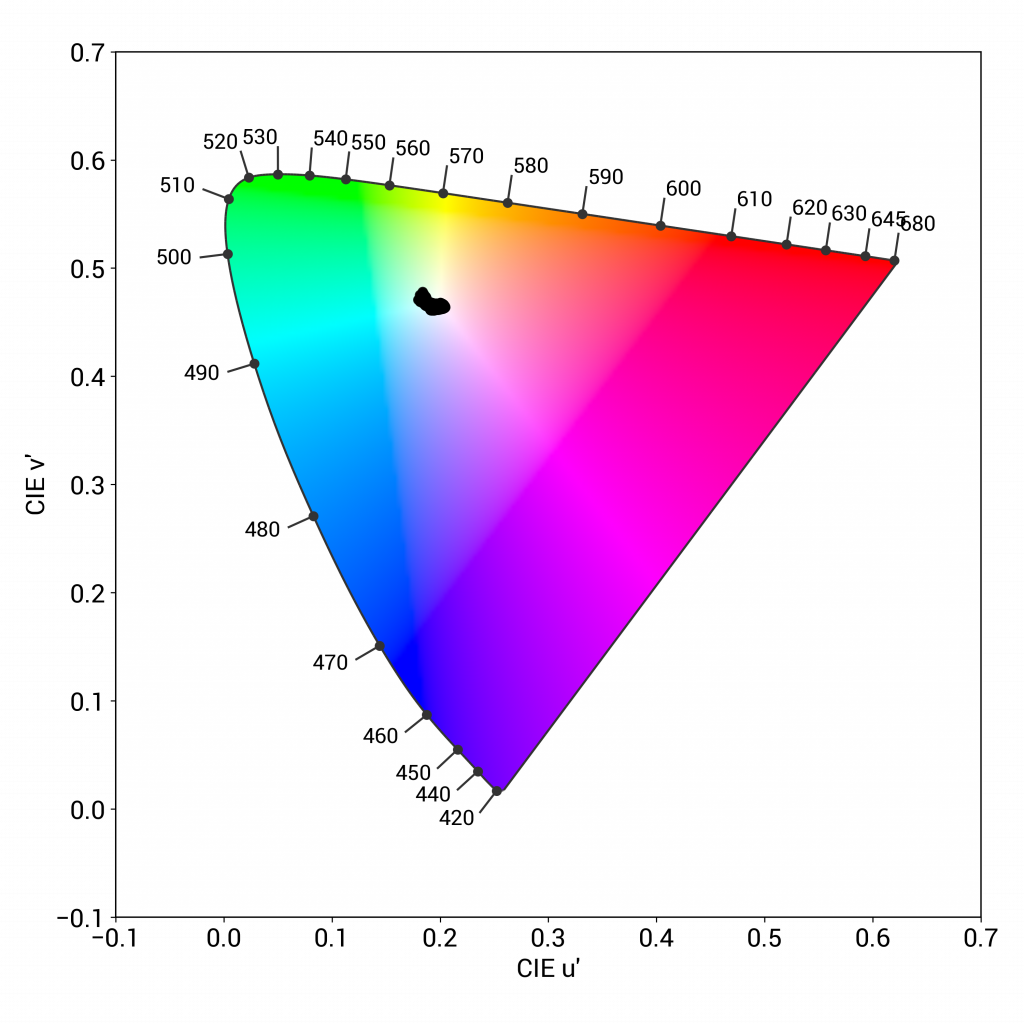
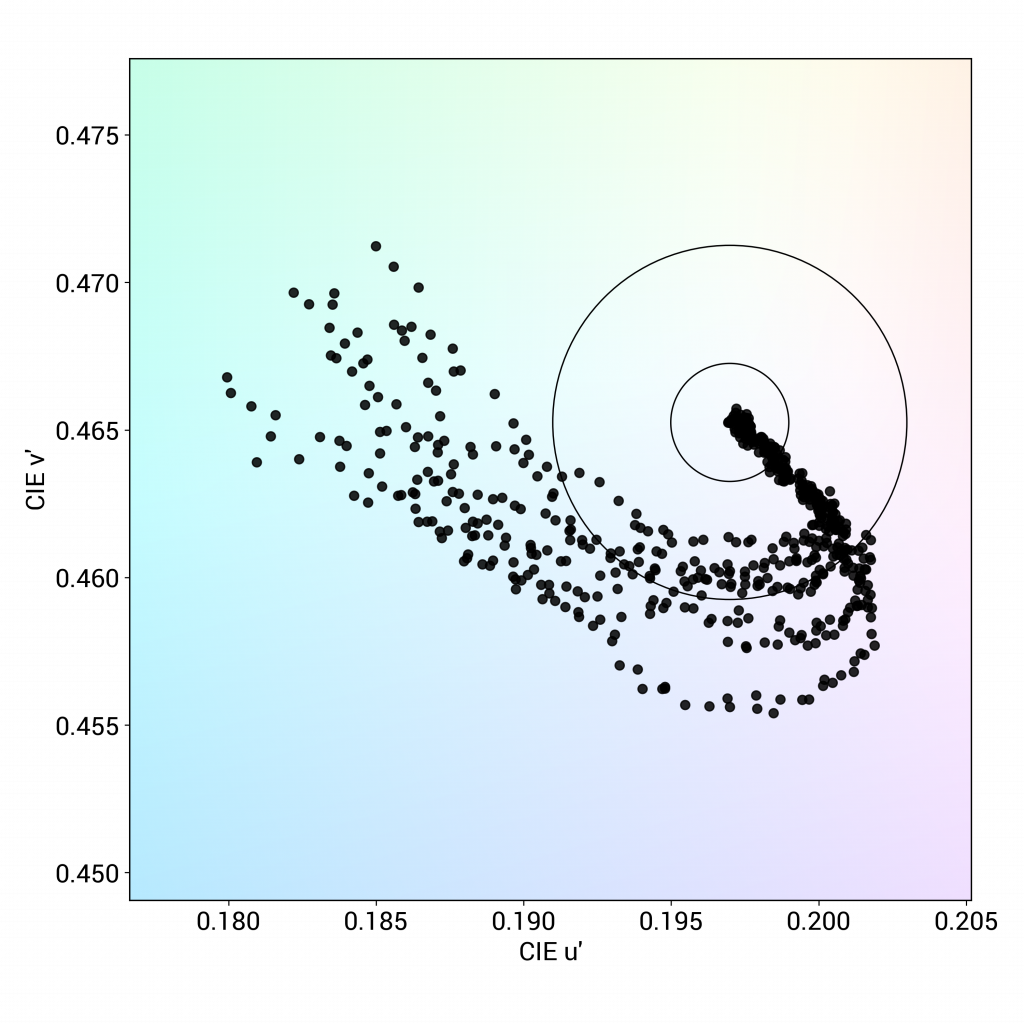
The photo arrays below illustrate the objective findings, and indeed, when viewed at 45° angle, images on the device take on a pink cast.



Color with blue light filter on, from left to right: Google Pixel 6 Pro, Samsung Galaxy S21 Ultra 5G (Snapdragon), Apple iPhone 13 Pro Max
Video
Google Pixel 6 Pro
162
Our video attribute evaluates the Standard Dynamic Range (SDR) and High Dynamic Range (HDR10) video handling of each device in indoor and low-light conditions. We measure tone mapping, color gamut, brightness and contrast of the display. We perform perceptual analysis against our professional reference monitor (Sony BVM-HX310) to ensure that the rendering respects the artistic intent.
At its default settings, the Google Pixel 6 Pro lacks brightness when displaying HDR10 videos, which affects contrast and results in darker details that are hardly visible, thus requiring the user to manually adjust the brightness.
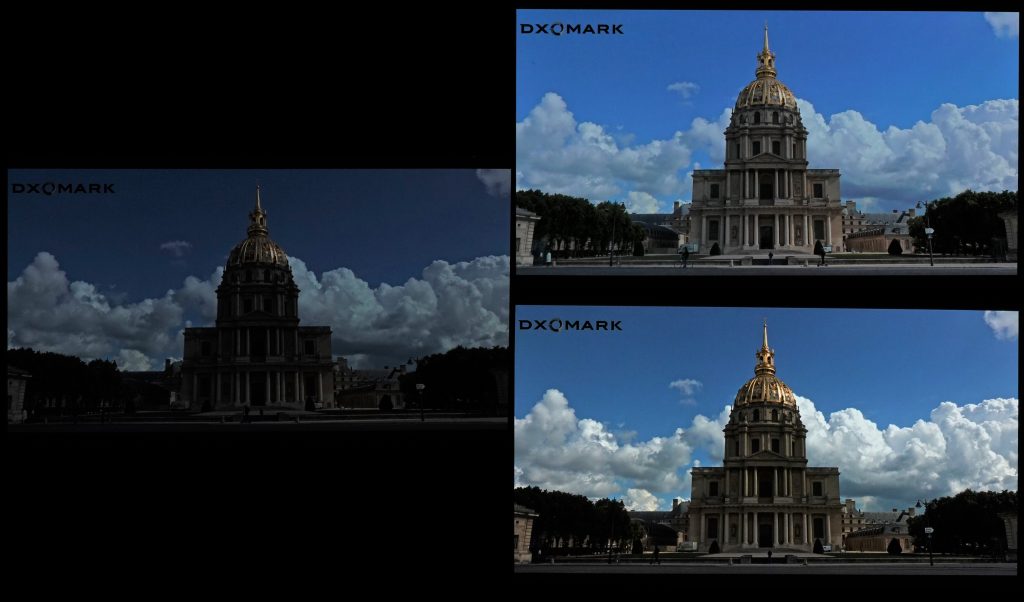
Clockwise from left: Google Pixel 6 Pro, Samsung Galaxy S21 Ultra 5G (Snapdragon), Apple iPhone 13 Pro Max
Color on HDR10 videos are quite faithful, however:
Motion
Google Pixel 6 Pro
155
The motion attribute evaluates the handling of dynamic contents. Frame drops, motion blur, and playback artifacts are scrutinized using games and videos.
The Google Pixel 6 Pro manages motion blur very well, with videos appearing sharp. While our tests show hardly any frame drops on 24 fps, 30 fps, and 60 fps content, stutters are frequently noticeable when playing video games. Another issue is that videos can take a few moments to resume after moving forward or backward in the timeline, and there is a slight jump backward before videos resume play.
Touch
Google Pixel 6 Pro
165
To evaluate touch, DXOMARK uses a touch robot and a high-speed camera to play and record a set of scenarios for smoothness, accuracy and response-time evaluation.
Zoom on the Google Pixel 6 Pro is accurate but capped, and the device feels smooth when browsing the web, scrolling through pictures, or playing video games. That smoothness, along with the fact that every part of the screen is easy to select, means that the phone offers a generally comfortable gaming experience.
Artifacts
Google Pixel 6 Pro
149
Evaluating artifacts means checking for the performance, image rendering and motion flaws that can affect the end-user experience. DXOMARK measures precisely the device’s reflectance and the presence of flicker, and assesses the impact of residual aliasing when playing video games, among other characteristics.
The Google Pixel 6 Pro manages judder well. It also manages ghost touches well when held in portrait orientation, but a few touches occur from time to time in landscape mode. Flicker is not an issue.
In the illustrations below, aliasing is noticeable on both the Google Pixel 6 Pro and the Samsung Galaxy S21 Ultra (Snapdragon), but the Apple iPhone 13 Pro Max’s contour lines are much smoother.

 English
English 中文
中文

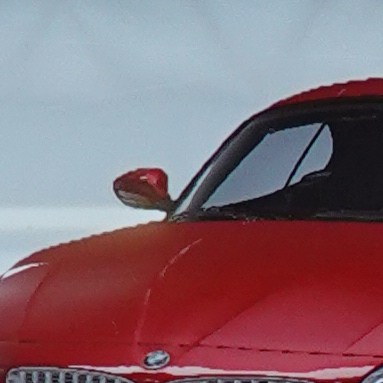
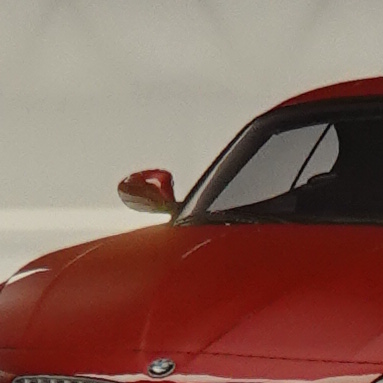
DXOMARK invites our readership (you) to post comments on the articles on this website. Read more about our Comment Policy.